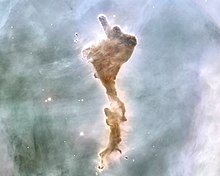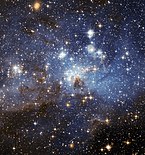| Bok globule | |
|---|---|
 The Finger of God Globule in the Carina Nebula | |
| Characteristics | |
| Type | Isolated Dark nebulae |
| Found | HII regions |
| Mass range | 2M☉-50M☉ |
| Chemical composition | Molecular hydrogen, carbon oxides, helium, and silicate dust |
| Size range | ~1ly |
| External links | |
| | |
| | |
| Additional Information | |
| Discovered | Bart Bok, 1940s |
| Star formation |
|---|
 |
| Object classes |
| Theoretical concepts |
In astronomy, Bok globules are isolated and relatively small dark nebulae containing dense cosmic dust and gas from which star formation may take place. Bok globules are found within H II regions, and typically have a mass of about two [1] to 50 solar masses contained within a region about a light year or so across (about 4.5×1047 m3). [2] They contain molecular hydrogen (H2), carbon oxides and helium, and around 1% (by mass) silicate dust. Bok globules most commonly result in the formation of double- or multiple-star systems. [3]



